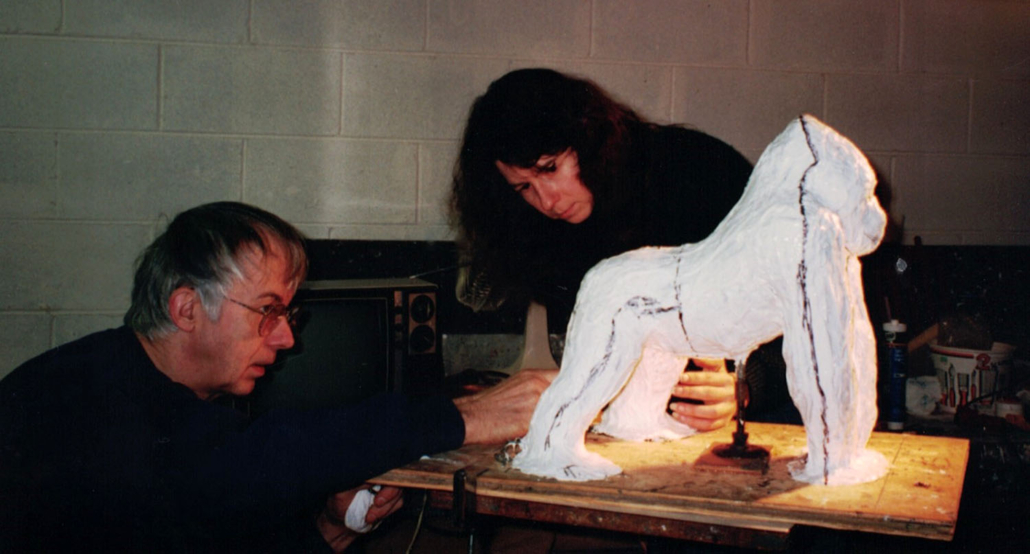The Artist and His Vision
A soft-spoken but passionate man, Edwin Bogucki was gifted with an innate curiosity about the world around him and an unparalleled artistic talent. These qualities became the cornerstone of a career that spanned more than 55 years. His body of work reflects a life-long pursuit of realism seen through the eyes of an artist obsessed with capturing the vibrancy of life.
If someone were to mention the words self-taught to Bogucki, he would quickly respond “I didn’t do it all by myself!” Insisting instead that, while his artistic techniques weren’t nurtured in a classroom, he had more instructors than any university could provide. “Hundreds and hundreds of people have touched my life. Experience creates an artist — he doesn’t just emerge from a cocoon like a butterfly.
“I have been so fortunate in my life. The good lord has provided exactly what I needed when I needed it. It’s funny how those things work out and lead you where you need to go.
A devoted husband to his wife Shirley and proud father of their four children, Bogucki understood the importance of family as a basis for the development of strong character. “My parents both came from Poland. My mother brought Poland with her to America while my father concentrated on becoming Americanized. My mother had a lot of tenacity and she would stick with things to the bitter end. My father always searched for the best way to do things. Together they gave me the ability to choose quality over quantity.
“My parents tried to keep me away from art, but in doing so they drove me deeper and further than I could have gone on my own. Actually, they thought it was wishful thinking. I was a dreamer.
“My father used to buy life magazine when I was a young boy. The art in it and the information about artists intrigued me. It frustrated me when my father would staple the pages together that he thought were not suitable for his children’s viewing. I would have to go to the corner drugstore to look at what was between those pages.
“My early education really began when I started wandering around and exploring at age five. It wasn’t quite as dangerous then as it is now. I used to think my mother was too strict but I realize now that she wasn’t always in control of where I was going or what I was doing.
“I lost track of time during my childhood and never got a hold of it again. I was always so preoccupied with what I was doing, whether I was out walking through fields or in the swamps or little creeks. I loved looking at crayfish and how they functioned.
“Interacting with the way things flow and move, watching animals, getting in the rhythm of nature is one of the greatest experiences a person can have. Everything is life and life is fascinating.
“I didn’t have a watch when I was a kid. If I had, I probably wouldn’t have paid attention to it anyway. When the sun went down, the cold reality would hit me that I hadn’t been home since morning. I wasn’t home for dinner. I didn’t make it for supper. I would come home so late and I would really get it, but it was worth it.
“It sounds like an excuse, but I just can’t keep track of time. My family teases me. They say I don’t need a clock, a calendar maybe, but not a clock. Whenever people see me, I’m dog tired. Everyone probably thinks that’s just how I am. It’s really only because I’ve been working all night.
“Working such long hours can be a curse and a blessing all in one. My work is self-perpetuating and it’s difficult to just stop anytime. When things are going well, I want to keep working to make the most of the creative flow. When things aren’t going smoothly, I have to stick to it until they do. I don’t want to walk away feeling discouraged.
“People often ask how long a particular piece took to create. I like to tell them ‘It’s taken my whole life.’ If I didn’t like what I do so much I think I would be able to tell them exactly how many hours I spend from beginning to end. Since I enjoy what I am doing, it doesn’t matter.
“The most important thing an artist can have, even more important than being able to create, is the ability to keep that fire going inside themselves. That drive, the obsessive and insatiable hunger and desire to create something all the time is essential. If your ideas have gotten stale or if you’re just coasting along because you think you’ve already arrived, you might as well pack your bags and get ready to cash in somehow because there’s nowhere to go from there. God forbid I ever assume that I have no more to learn. That is the kiss of death for the creative process.
“If you’re open to new ideas you will always know there has to be something better in you. It’s what they call divine discontent. If you have divine discontent, you have the greatest gift going. It’s not something that hinders you. It gives you an edge, drives you and makes you hungry for something else. It makes you want to do better. You compete against yourself rather than someone else.
“I find that I am constantly pushing myself. Making myself try things that might not even work. Sometimes I start to feel pressured and cranky. Pushing yourself can be laborious and frustrating. Things don’t always come along as fast as you’d like or need them to. The reward comes when a piece finally starts to flow along smoothly.
“The feeling that the subject transfers to me is the most valuable thing at the beginning of a new project. When I receive a commission, I need to go and see the animal. I spend time with the subject, taking videos, photos, and measurements. Pictures are good tools for memory, but when you only see things through a camera’s single lens it’s never as educational as seeing with your eyes and your heart.
“Every horse has different characteristics and a unique personality. If you can lay that back out to people so that they can see it just as you saw it, then you’ve succeeded.
“For me, horses were always easy to get excited about. I saw my first horse when I was two and have loved them ever since.” Bogucki owned horses for the majority of his life. With their barn only a few steps from the studio door of the home he designed, the artist was able to visit his living reference models whenever necessary. One horse in particular, an Egyptian Arabian stallion named Cairo Mareekh became the artist’s greatest muse. “. . . a dappled black bay with eyes that radiate pure fire. Electrical energy seems to come right out of that glossy hide. He was born here at our place and I’ve taken care of him ever since. Even after all this time, it gives me such a thrill when he comes charging into the barn, arching his neck and ‘talking’ to me. I thank God that I am blessed with the company of such a magnificent animal.
“This spiritual connection with an animal is crucial to my work. I feel that I am what I create and I apply the Stanislowski method of acting to my sculpting. I imagine that I am the horse, the rider, the hounds, etc.”
“Each piece of work is a part of me. I am making a record of my life. These are the only things of me that I can leave behind, other than my children. While grandchildren or great grand-children may forget or never even know my thoughts and ideas, a piece in bronze or a painting can affect people long after I’m gone. They will speak for me.
“If you lose the capacity to dream and wish it’s a tragedy, but if you lose the capacity to act on your dreams and wishes that is much worse. One has to be able to follow what they think and feel, or there isn’t much point. That goes for anything you do in life.
“I believe I’m here to create something that I think is beautiful. If it survives the ages because someone else thought it was beautiful too, my efforts will have been worthwhile.”
Quotations from a recorded conversation between Ed Bogucki and his Daughter, Kathi, in 1993.





